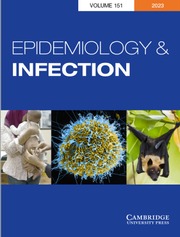Crossref Citations
This article has been cited by the following publications. This list is generated based on data provided by
Crossref.
Riffelmann, Marion
Littmann, Martina
Hellenbrand, Wiebke
Hülße, Christel
and
König, Carl Heinz Wirsing von
2008.
Pertussis.
Deutsches Ärzteblatt international,
Harris, John P.
Edmunds, W. John
Pebody, Richard
Brown, David W.
and
Lopman, Ben A.
2008.
Deaths from Norovirus among the Elderly, England and Wales.
Emerging Infectious Diseases,
Vol. 14,
Issue. 10,
p.
1546.
Gilca, R.
De Serres, G.
Skowronski, D.
Boivin, G.
and
Buckeridge, D. L.
2009.
The Need for Validation of Statistical Methods for Estimating Respiratory Virus-Attributable Hospitalization.
American Journal of Epidemiology,
Vol. 170,
Issue. 7,
p.
925.
Ladhani, Shamez
Pebody, Richard G.
Ramsay, Mary E.
Lamagni, Theresa L.
Johnson, Alan P.
and
Sharland, Mike
2010.
Continuing Impact of Infectious Diseases on Childhood Deaths in England and Wales, 2003–2005.
Pediatric Infectious Disease Journal,
Vol. 29,
Issue. 4,
p.
310.
Lopman, Ben A.
Hall, Aron J.
Curns, Aaron T.
and
Parashar, Umesh D.
2011.
Increasing Rates of Gastroenteritis Hospital Discharges in US Adults and the Contribution of Norovirus, 1996–2007.
Clinical Infectious Diseases,
Vol. 52,
Issue. 4,
p.
466.
Campbell, Helen
Amirthalingam, Gayatri
Andrews, Nick
Fry, Norman K.
George, Robert C.
Harrison, Timothy G.
and
Miller, Elizabeth
2012.
Accelerating Control of Pertussis in England and Wales.
Emerging Infectious Diseases,
Vol. 18,
Issue. 1,
p.
38.
van Asten, Liselotte
van den Wijngaard, Cees
van Pelt, Wilfrid
van de Kassteele, Jan
Meijer, Adam
van der Hoek, Wim
Kretzschmar, Mirjam
and
Koopmans, Marion
2012.
Mortality Attributable to 9 Common Infections: Significant Effect of Influenza A, Respiratory Syncytial Virus, Influenza B, Norovirus, and Parainfluenza in Elderly Persons.
The Journal of Infectious Diseases,
Vol. 206,
Issue. 5,
p.
628.
Gastanaduy, P. A.
Hall, A. J.
Curns, A. T.
Parashar, U. D.
and
Lopman, B. A.
2013.
Burden of Norovirus Gastroenteritis in the Ambulatory Setting--United States, 2001-2009.
Journal of Infectious Diseases,
Vol. 207,
Issue. 7,
p.
1058.
Williams, Eleri J
Embleton, Nicholas D
Bythell, Mary
Ward Platt, Martin P
and
Berrington, Janet E
2013.
The changing profile of infant mortality from bacterial, viral and fungal infection over two decades.
Acta Paediatrica,
Vol. 102,
Issue. 10,
p.
999.
Rha, Brian
Burrer, Sherry
Park, Soyoun
Trivedi, Tarak
Parashar, Umesh D.
and
Lopman, Benjamin A.
2013.
Emergency Department Visit Data for Rapid Detection and Monitoring of Norovirus Activity, United States.
Emerging Infectious Diseases,
Vol. 19,
Issue. 8,
p.
1214.
Fisher, Michael L.
Sun, Wei
and
Curtiss, Roy
2014.
The route less taken: pulmonary models of enteric Gram-negative infection.
Pathogens and Disease,
Vol. 70,
Issue. 2,
p.
99.
Solano, Rubén
Rius, Cristina
Simón, Pere
Manzanares-Laya, Sandra
Ros, Miriam
Toledo, Diana
Domíngez, Àngela
and
Caylà, Joan A.
2014.
Evaluation of reported cases of pertussis: epidemiological study in a large city in Spain.
Journal of Medical Microbiology
,
Vol. 63,
Issue. 12,
p.
1688.
Rha, Brian
Lopman, Benjamin A.
Alcala, Ashley N.
Riddle, Mark S.
Porter, Chad K.
and
Baradaran, Hamid Reza
2016.
Incidence of Norovirus-Associated Medical Encounters among Active Duty United States Military Personnel and Their Dependents.
PLOS ONE,
Vol. 11,
Issue. 4,
p.
e0148505.
Verstraeten, Thomas
Jiang, Baoguo
Weil, John G.
Lin, Jennifer H.
and
Dowdy, David W.
2016.
Modelling Estimates of Norovirus Disease in Patients with Chronic Medical Conditions.
PLOS ONE,
Vol. 11,
Issue. 7,
p.
e0158822.
Burke, Rachel M
Shih, Shu-Man
Yen, Catherine
Huang, Yhu-Chering
Parashar, Umesh D
Lopman, Benjamin A
Wu, Fang-Tzy
Hsiung, Chao Agnes
and
Hall, Aron J
2018.
Burden of Severe Norovirus Disease in Taiwan, 2003–2013.
Clinical Infectious Diseases,
Vol. 67,
Issue. 9,
p.
1373.
Gregianini, Tatiana Schäffer
Seadi, Claudete Farina
Zavarize Neto, Luiz Domingos
Martins, Letícia Garay
Muller, Guilherme Cerutti
Straliotto, Selir Maria
and
Veiga, Ana Beatriz Gorini da
2019.
A 28‐year study of human parainfluenza in Rio Grande do Sul, Southern Brazil.
Journal of Medical Virology,
Vol. 91,
Issue. 8,
p.
1423.
Watson, Alastair
and
Wilkinson, Tom M. A.
2021.
Respiratory viral infections in the elderly.
Therapeutic Advances in Respiratory Disease,
Vol. 15,
Issue. ,
Schwanz, Thomas
2022.
Erregerlexikon: Bordetella pertussis
.
Krankenhaushygiene up2date,
Vol. 17,
Issue. 02,
p.
141.
Cong, Bingbing
Dighero, Izzie
Zhang, Tiantian
Chung, Alexandria
Nair, Harish
and
Li, You
2023.
Understanding the age spectrum of respiratory syncytial virus associated hospitalisation and mortality burden based on statistical modelling methods: a systematic analysis.
BMC Medicine,
Vol. 21,
Issue. 1,

